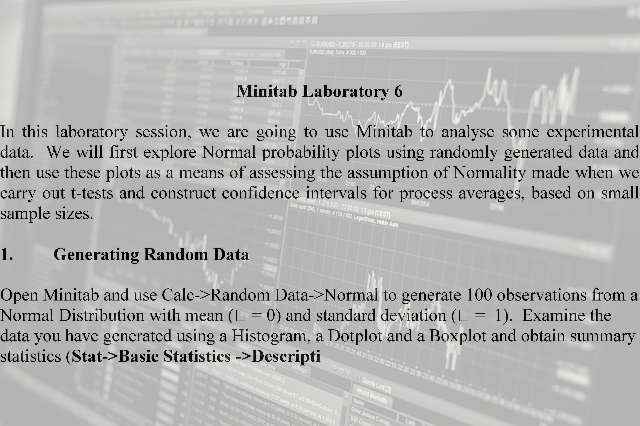(Solution) In this laboratory session, we are going to use Minitab - #80054
Minitab Laboratory 6
In this laboratory session, we are going to use Minitab to analyse some experimental data. We will first explore Normal probability plots using randomly generated data and then use these plots as a means of assessing the assumption of Normality made when we carry out t-tests and construct confidence intervals for process averages, based on small sample sizes.
1. Generating Random Data
Open Minitab and use Calc->Random Data->Normal to generate 100 observations from a Normal Distribution with mean ( = 0) and standard deviation ( = 1). Examine the data you have generated using a Histogram, a Dotplot and a Boxplot and obtain summary statistics (Stat->Basic Statistics ->Descriptive Statistics).
Select Edit->Command Line Editor and type in the command nscores c1 c2. This calculates Normal scores for the data, which are then used to obtain Normal probability plots. Use Scatterplot from the Graphs menu to obtain a Normal probability plot. Plot c1 vs c2.
Repeat this whole process a few times to see the kind of variability that can be expected from Normal Probability plots based on samples of 100.
To see what kind of probability plots can be expected from skewed data generate 100 data points from a Normal Distribution into c1, then let c2 equal c1 squared: to do this, select Edit->Command Line Editor and type let c2 = c1 * c1. Now repeat the above process on c2. Draw a histogram, boxplot and dotplot of c2.
Repeat the whole procedure now for small sample sizes. Say 5, 10, 15 and 20.
2 Paired t-tests.
Type the rubber data into c1 and c2 and let c3 = c2 - c1 in the session window. Column three now contains the set of differences, which we assume are random drawing from a Normal distribution. Assume for the moment that this assumption is valid and carry out a t-test of the hypothesis that the average difference is zero: this can be done using the Stat->Basic Statistics->1 Sample t sequence of menu options. The options button will allow you to construct a confidence interval for the average difference.
The test and confidence interval depend on the assumption of Normality of the differences. Construct a Normality probability plot to check this assumption. Generate a number of sets of Normal data with the same mean and standard deviation as the rubber data. Notice the variability - this should warn us not to over-intepret a Normal probability plot based on small numbers of observations.
3 Two sample t-tests
Type the yield data into c4 and c5 (or C1 and C2 of a new worksheet). Graph the data using Graph->Dotplots. What can be learned from this graph? Obtain descriptive statistics.
To do a two sample t-test and get a confidence interval for the difference between the two population means use Stat->Basic Statistics->2-sample t; select samples in different columns and assume equal variances. Interpret the output.
To obtain a Normal probability plot of the deviations from the respective means, first calculate the deviations by subtracting the means from the data. In the command line editor
let c6 = c4 - mean(c4)
let c7 = c5 - mean(c5)
stack c6 c7 c8
nscore c8 c9
Now do a scatterplot of c8 versus c9.
Assessment
Analyse the four data sets and produce a statistical report of your main findings. Your report should include for each data set,
1 appropriate descriptive statistics and graphs (10%) with commentary (10%),
2 a check on assumptions (10%) with commentary (10%),
3 results of appropriate tests and confidence intervals (15%) with commentary (15%),
4 and interpretation / summary of findings (30%).
Deliverable: Word Document
 and pdf
and pdf




![[Solution] Alan Green, an analyst with Pilgrim Bank, needs to prepare - #80214 Statistics](/images/projects/project-80214/statistics-1.jpg)
